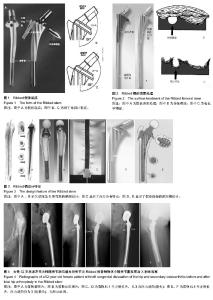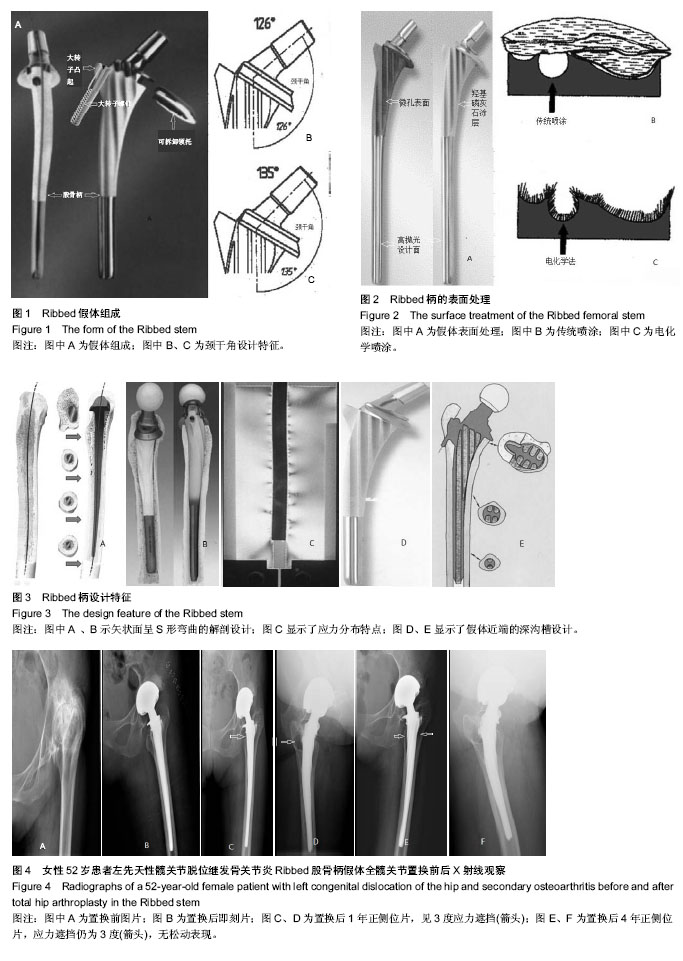Chinese Journal of Tissue Engineering Research ›› 2014, Vol. 18 ›› Issue (40): 6425-6431.doi: 10.3969/j.issn.2095-4344.2014.40.006
Previous Articles Next Articles
Design features and clinical results of anatomic femoral stem in total hip arthroplasty
Jiang Tao, Sun Jun-ying, Zha Guo-chun, You Zhen-jun, Wang Tao
- Department of Orthopedics, First Affiliated Hospital of Soochow University, Suzhou 215006, Jiangsu Province, China
-
Revised:2014-08-22Online:2014-09-24Published:2014-09-24 -
Contact:Sun Jun-ying, Professor, Doctoral supervisor, Department of Orthopedics, First Affiliated Hospital of Soochow University, Suzhou 215006, Jiangsu Province, China -
About author:Jiang Tao, Studying for master’s degree, Department of Orthopedics, First Affiliated Hospital of Soochow University, Suzhou 215006, Jiangsu Province, China
CLC Number:
Cite this article
Jiang Tao, Sun Jun-ying, Zha Guo-chun, You Zhen-jun, Wang Tao. Design features and clinical results of anatomic femoral stem in total hip arthroplasty[J]. Chinese Journal of Tissue Engineering Research, 2014, 18(40): 6425-6431.
share this article

2.1 参与者数量分析 按照意向性处理,截止随访末期,52例应用Ribbed柄全髋关节置换的患者均进入结果分析,无脱落。 2.2 临床疗效 术中出现股骨骨折3例,所有骨折均获骨性愈合。 平均Harris评分由置换前48分(18-63分)提高到末次随访时96分(71-100分);置换后3例(6%)出现大腿痛(2例轻度、1例中度疼痛),但均于置换后1年消失。末次随访时,术中发生骨折患者与未发生骨折患者的Harris评分差异无显著性意义(P > 0.05)。 2.3 影像学结果 置换前X射线片显示股骨髓腔类型:Dorr A型41髋(79%)、Dorr B型5髋(10%)、Dorr C型6髋(12%)。置换后即刻X射线片示:股骨假体中立位46髋(89%)、内翻(< 4°)2髋(4%)、外翻(< 4°)4髋(8%);所有患者股骨髓腔充填满意,平均充填率:正位片上干骺段、中段和远段分别为91%,88%和86%,侧位片上干骺段、中段和远段分别为88%,85%和81%;髋臼杯平均外展角和前倾角分别为41° (31°-51°)和14°(7°-19°)。 采用陶瓷对陶瓷摩檫界面45髋(均采用BETA髋臼杯),聚乙烯对陶瓷界面7髋(均采用T.O.P髋臼杯),36 mm股骨头35髋,28 mm股骨头17髋。陶瓷均为德国CeramTec公司生产的第4代纳米复合陶瓷(Biolox Delta),随访中无陶瓷碎裂。 末次随访时,49髋(92%)为稳定性骨性长入固定(点焊征位于2区28髋、3区8髋、5区9髋、6区19髋),3髋为稳定性纤维长入固定。股骨和髋臼假体均未观察到连续性X射线透亮线。髋臼侧,1髋(2%)显示宽度为0.7 mm的不连续X射线透亮线,位于Ⅱ区;股骨侧,8髋(15%)在假体周围显示宽度< 2 mm的不连续X射线透亮线,其中Ⅰ区5髋、Ⅱ区1髋、Ⅲ区2髋、Ⅶ区7髋。股骨侧和髋臼侧假体周围均未显示骨溶解。 末次随访时,5髋(10%)发生股骨柄假体下沉(Dorr A型1髋、Dorr B型3髋、Dorr C型1髋),但无一髋显示下沉>2 mm;所有患者均出现不同程度的应力遮挡现象,其中1度31髋、2度19髋、3度2髋,无4度应力遮挡发生。 共9髋(17%)出现异位骨化,其中1度5髋,2度4髋,未出现3度或4度异位骨化。 2.4 典型病例 女性患者,52岁,左髋关节疼痛活动受限,诊断为左先天性髋关节脱位,患者采用Ribbed股骨柄假体置入治疗,随访4年,假体位置良好,无松动表现(图4)。 2.5 不良事件 纳入患者术中出现股骨骨折3例(6%),1例发生于股骨近段扩髓时,另2例发生于安装假体时。3例骨折中,1例为股骨大转子骨折(采用钢丝捆扎),余2例均发生于股骨矩,其中Mallory Ⅰ型骨折1例(无需钢丝捆扎)、Mallory Ⅱ型骨折1例(采用钢丝捆扎)、未发生Mallory Ⅲ型骨折;术中未出现骨皮质穿透性骨折或股骨干部骨折;包括转子下截骨1例;所有骨折均获骨性愈合。未出现感染、脱位和神经血管损伤等并发症。"

| [1] 孙俊英.人工髋关节翻修手术学[M].1版. 北京:人民军医出版社, 2012:2.
[2] ]Khanuja HS, Vakil JJ, Goddard MS, et al. Cementless femoral fixation in total hip arthroplasty. J Bone Joint Surg Am. 2011;93(5):500-509.
[3] Issa K, Pivec R, Wuestemann T, et al. Radiographic fit and fill analysis of a new second-generation proximally coated cementless stem compared to its predicate design. J Arthroplasty. 2014;29(1):192-198.
[4] Hwang BH, Lee WS, Park KK, et al. Straight tapered titanium stem with alumina bearing in cementless primary total hip arthroplasty: a minimum 5-year follow-up. J Arthroplasty. 2011; 26(8):1310-1317.
[5] 刘明,王岩,陈继营,等.1436髋Ribbed假体单中心应用分析[J].中国矫形外科杂志,2008,16(14):1051-1053.
[6] 史庆轩,李佩佳,孙磊,等.662髋Ribbed假体中远期临床疗效观察[J].中国矫形外科杂志,2012,20(15):1370-1373.
[7] 雷光华,曾凯斌,李康华,等.解剖型非骨水泥全髋人工关节置换术近中期疗效研究[J].中国修复重建外科杂志,2007,21(3):244- 246.
[8] Sweetnam DI, Lavelle J, Allwood WM, et al. Poor results of the Ribbed Hip System for cementless replacement. J Bone Joint Surg Br. 1995;77(3):366-368.
[9] Petrou G, Gavras M, Diamantopoulos A, et al. Uncemented total hip replacements and thigh pain. Arch Orthop Trauma Surg. 1994;113(6):322-326.
[10] Kärrholm J, Snorrason F.Subsidence, tip, and hump micromovements of noncoated ribbed femoral prostheses. Clin Orthop Relat Res. 1993;(287):50-60.
[11] Tonino AJ, Therin M, Doyle C. Hydroxyapatite coated femoral stems: Histology and histomorphometry around five components retrieved at postmortem. J Bone Joint Surg Br. 1999;81(1):148-154.
[12] Herrera A, Panisello JJ, Cegoñino EL, et al. Densitometric and finite-element analysis of bone remodeling further to implantation of an uncemented anatomical femoral stem. Revista Española de Cirugía Ortopédicay Traumatología (English Edition)。 2008;52(5):269-282.
[13] 周一新.骨科标准新突破手术技术指导规范-《人工髋、膝关节置换术》解读[J].中国卫生标准管理,2011,2(4):72-74.
[14] Mallory TH, Kraus TJ, Vaughn BK. Intraoperative femoral fractures associated with cementless total hip arthroplasty. Orthopedics. 1989;12(2):231-239.
[15] Kim YH, Park JW, Kim JS. Cementless metaphyseal fitting anatomic total hip arthroplasty with a ceramic-on-ceramic bearing in patients thirty years of age or younger. J Bone Joint Surg Am. 2012;94(17):1570-1575.
[16] 魏召劝,孙俊英,查国春,等.采用高交联聚乙烯与传统聚乙烯髋臼内衬行人工全髋关节置换的比较研究[J].中国修复重建外科杂志,2013, 27(12): 1414-1418.
[17] Dorr LD. Total hip replacement using APR system. Tech Orthop. 1986;1:22-34.
[18] Kim YH, Kim VE. Uncemented porous-coated anatomic total hip replacement. Results at six years in a consecutive series. J Bone Joint Surg Br. 1993;75(1):6-13.
[19] Gruen TA, McNeice GM, Amstutz HC. "Modes of failure" of cemented stem-type femoral components: a radiographic analysis of loosening. Clin Orthop Relat Res. 1979;(141): 17-27.
[20] DeLee JG, Charnley J. Radiological demarcation of cemented sockets in total hip replacement. Clin Orthop Relat Res. 1976; (121):20-32.
[21] Engh CA, Bobyn JD, Glassman AH. Porous-coated hip replacement. The factors governing bone ingrowth, stress shielding, and clinical results. J Bone Joint Surg Br.1987; 69(1): 45-55.
[22] Nishino T, Mishima H, Kawamura H, et al. Follow-up results of 10-12 years after total hip arthroplasty using cementless tapered stem -- frequency of severe stress shielding with synergy stem in Japanese patients. J Arthroplasty. 2013; 28(10):1736-1740.
[23] Engh CA, Bobyn JD. The influence of stem size and extent of porous coating on femoral bone resorption after primary cementless hip arthroplasty. Clin Orthop. 1988;(231):7-28.
[24] Brooker AF, Bowerman JW, Robinson RA, et al. Ectopic ossification following total hip replacement: incidence and a method of classification. J Bone Joint Surg. 1973;55(8): 1629-1632.
[25] McLaughlin JR, Lee KR. Total hip arthroplasty with an uncemented tapered femoral component in patients younger than 50 years. J Arthroplasty. 2011;26(1):9-15.
[26] Tarala M, Janssen D, Verdonschot N. Balancing incompatible endoprosthetic design goals: a combined ingrowth and bone remodeling simulation. Med Eng Phys. 2011;33(3):374-380.
[27] Kaneuji A, Sugimori T, Ichiseki T, et al. Cementless anatomic total hip femoral component with circumferential porous coating for hips with developmental dysplasia: a minimum ten-year follow-up period. J Arthroplasty. 2013;28(10): 1746-1750.
[28] Loughead JM, O'Connor PA, Charron K, et al. Twenty-three-year outcome of the porous coated anatomic total hip replacement: a concise follow-up of a previous report. J Bone Joint Surg Am. 2012;94(2):151-155.
[29] Galante J, Rostoker W, Lueck R, et al. Sintered fiber metal composites as a basis for attachment of implants to bone. J Bone Joint Surg Am. 1971;53(1):101-114.
[30] Engh CA, O’Connor D, Jasty M, et al. Quantification of implant micromotion, strain shielding, and bone resorption with porouscoated anatomic medullary locking femoral prostheses. Clin Orthop Relat Res. 1992;(285):13-29.
[31] Pilliar RM, Lee JM, Maniatopoulos C. Observations on the effect of movement on bone ingrowth into porous-surfaced implants. Clin Orthop Relat Res. 1986;(208):108-113.
[32] Jasty M, Bragdon C, Burke D, et al. In vivo skeletal responses to porous-surfaced implants subjected to small induced motions. J Bone Joint Surg Am. 1997;79(5):707-714.
[33] Soballe K. Hydroxyapatite ceramic coating for bone implant fixation. Mechanical and histological studies in dogs. Acta Orthop Scand Suppl. 1993; 255:1-58.
[34] Melero H, Fargas G, Garcia-Giralt N, et al. Mechanical performance of bioceramic coatings obtained by high-velocity oxy-fuel spray for biomedical purposes. Surface Coatings Technology. 2004;242:92-99.
[35] Surmenev RA, Surmeneva MA, Ivanova AA. Significance of calcium phosphate coatings for the enhancement of new bone osteogenesis--a review. Acta Biomater. 2014;10(2): 557-579.
[36] 孙俊英.人工关节有关基础与临床问题[J].中华创伤杂志,2007, 23(11):801-804.
[37] Berend KR, Lombardi AV Jr. Intraoperative femur fracture is associated with stem and instrument design in primary total hip arthroplasty. Clin Orthop Relat Res. 2010;468(9):2377-2381.
[38] Santori FS, Chera S, Moriconi A, et al. Results of cementless prosthesis with different types hedroxyapatite-coating. Orthopedics. 2001;24(12):1147-1150.
[39] Gosens T, Van Langelaan EJ, Tonino AJ. Cementless Mallory-head HA-coated hip arthroplasty for osteoarthritis in hip dysplasia. J Arthroplasty. 2003;18(4):401-410.
[40] Rüdiger HA, Betz M, Zingg PO, et al. Outcome after proximal femoral fractures during primary total hip replacement by the direct anterior approach. Arch Orthop Trauma Surg. 2013; 133(4):569-573.
[41] Lindahl H.Epidemiology of periprosthetic femur fracture around a total hip arthroplasty. Injury. 2007;38(6):651-654.
[42] Dalury DF, Kelley TC, Adams MJ. Modern Proximally Tapered Uncemented Stems Can Be Safely Used in Dorr Type C Femoral Bone. J Arthroplasty. 2012;27(6):1014-1018. |
| [1] | Liang Xin, Wang Heng, Li Xian-rong. Preoperative application of alprazolam for patients with anxiety and depression and pain after total knee arthroplasty: its safety and effectiveness [J]. Chinese Journal of Tissue Engineering Research, 2017, 21(7): 985-992. |
| [2] | Shi Bin, An Jing, Chen Long-gang, Zhang Nan, Tian Ye . Influencing factors for pain after total knee arthroplasty [J]. Chinese Journal of Tissue Engineering Research, 2017, 21(7): 993-997. |
| [3] | Wang Xian-xun. Impact of local compression cryotherapy combined with continuous passive motion on the early functional recovery after total knee arthroplasty [J]. Chinese Journal of Tissue Engineering Research, 2017, 21(7): 998-1003. |
| [4] | Lu Yao-jia, Xiong Chuan-zhi, Li Xiao-lei, Hu Han-sheng, Chen Gang, Wang Qiang, Lu Zhi-hua. Comparison of two methods for reducing blood loss during total knee arthroplasty [J]. Chinese Journal of Tissue Engineering Research, 2017, 21(7): 1004-1008. |
| [5] | Yuan Wei, Zhao Hui, Ding Zhe-ru, Wu Yu-li, Wu Hai-shan, Qian Qi-rong. Association between psychological resilience and acute mental disorders after total knee arthroplasty [J]. Chinese Journal of Tissue Engineering Research, 2017, 21(7): 1015-1019. |
| [6] | Chen Qun-qun, Qiao Rong-qin, Duan Rui-qi, Hu Nian-hong, Li Zhao, Shao Min. Acu-Loc®2 volar distal radius bone plate system for repairing type C fracture of distal radius [J]. Chinese Journal of Tissue Engineering Research, 2017, 21(7): 1025-1030. |
| [7] | Ye Xiang-yang, Sun Xiang, Tang Li-xin, Zhen Ping, Geng Bin, Wang Hua-lei, Zhao Yu-guo. Acetabular liner wear of cross-linked versus conventional polyethylene for total hip arthroplasty: a meta-analysis [J]. Chinese Journal of Tissue Engineering Research, 2017, 21(7): 1143-1148. |
| [8] | Tian Hai-tao, Wang Yuan-he, Tian Shao-qi, Zhang Xu-teng, Sun Kang. Effects and safety assessment of methylprednisolone on postoperative nausea and vomiting and pain after total knee arthroplasty [J]. Chinese Journal of Tissue Engineering Research, 2017, 21(3): 335-339. |
| [9] | Jia Jin-ling, Dong Yu-zhen. Finite element analysis of prosthesis position during hip arthroplasty [J]. Chinese Journal of Tissue Engineering Research, 2017, 21(3): 401-405. |
| [10] | Zhu Shi-bai, Zhai Jie, Jiang Chao, Ye Can-hua, Chen Xi, Weng Xi-sheng, Qian Wen-wei. Application of “enhanced recovery after surgery” in the perioperative period of total knee arthroplasty [J]. Chinese Journal of Tissue Engineering Research, 2017, 21(3): 456-463. |
| [11] | Wei Zhi-hui, Zhang Zhong-zu, Zhang Ming-hua. Intravenous combined with topical application of tranexamic acid in primary total hip arthroplasty: a meta-analysis of efficacy and safety [J]. Chinese Journal of Tissue Engineering Research, 2017, 21(3): 464-470. |
| [12] | Hu Jun, Zhang De-qiang, Tang Xin. Postoperative quality of life of internal fixation versus hemiarthroplasty for femoral neck fractures in the elderly [J]. Chinese Journal of Tissue Engineering Research, 2017, 21(19): 2953-2960. |
| [13] | Sun Hao, Wei Jun-qiang, Liu Li-rui, Yan Shi, Jin Yu, Feng Zhen. Time of lower extremity deep venous thrombosis after hip arthroplasty in senile patients with osteoporotic femoral neck fractures [J]. Chinese Journal of Tissue Engineering Research, 2017, 21(19): 2961-2965. |
| [14] |
Gao Wei-lu, Li Hong, Liu Bi-quan, Hu Yong, Liu Jing-jun, Yin Li, Liu Hu, Mei Bin, Yin Zong-sheng.
Analgesic effect of femoral and sciatic nerve block under multimodal analgesia in total knee arthroplasty
|
| [15] | Bai Zhao-hui, Zhang Ying, Yin Qing-shui, Xia Hong, Wang Jian-hua, Xu Jun-jie. Navigational template applied in the orthopaedic field in China: a bibliometric analysis [J]. Chinese Journal of Tissue Engineering Research, 2017, 21(19): 3023-3030. |
| Viewed | ||||||
|
Full text |
|
|||||
|
Abstract |
|
|||||